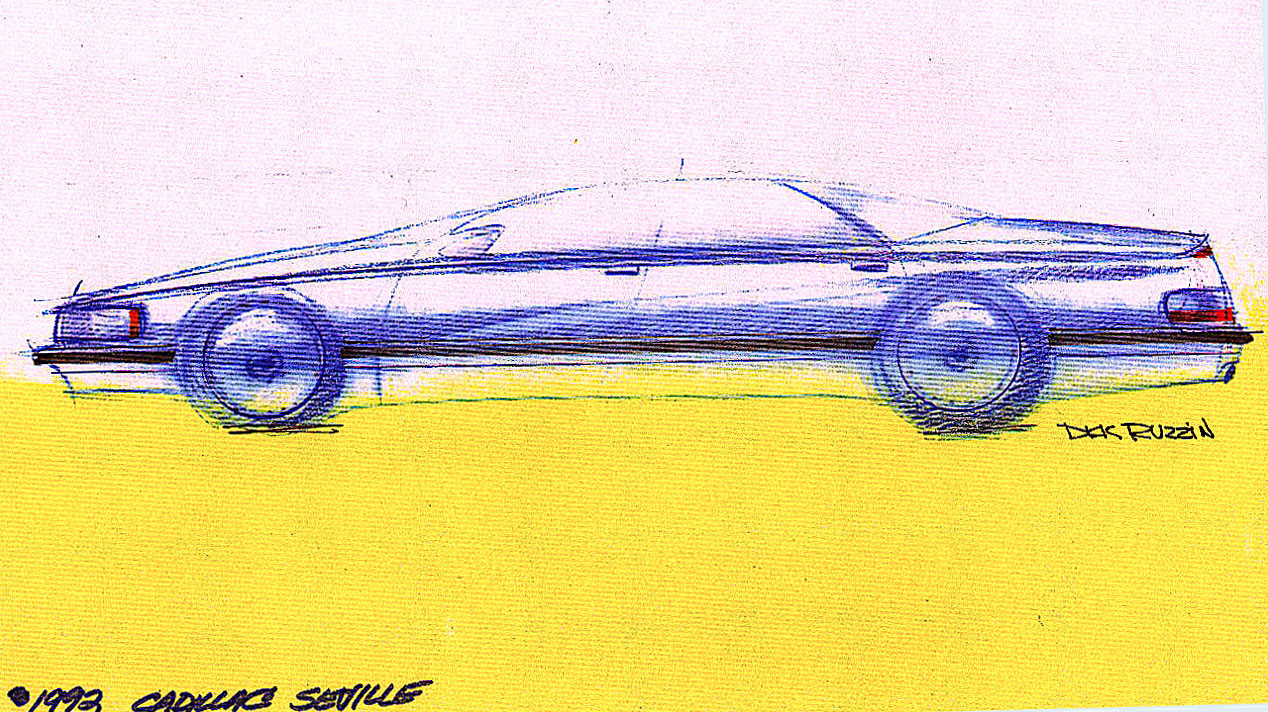
This small sketch was created for the introduction of the 1992 Seville one year early at the North American International Auto Show in Detroit in January of 1991. It represents the spirit of the design that was created by the Cadillac Studio team at General Motors Design Staff.
By Dick Ruzzin
Photos courtesy GM Design Archives
The 1992 Cadillac Eldorado and Seville were a turning point for the American automobile industry. The new Cadillacs clearly showed for the first time that their light weight and fuel-efficient luxury cars could match those of the European manufacturers. The Seville won the 1992 Car of The Year Awards from the four major American automotive magazines as well as the 1992 Industrial Design Excellence Award from the Industrial Design Society of America. The aerodynamic, sporty and elegant designs with internationally recognized performance and appearance represented a new Cadillac culture that inspired them again to seek to become the Standard of the World. No automobile had ever won every leading magazine award until Cadillac did in 1992. But getting to that point meant an intense competition with the most prestigious design offices in the world, Pininfarina. This is the story as told by the leader of the design team at Cadillac, a contributor to VeloceToday we all know, Dick Ruzzin.
My father had long promised to give a new Cadillac to my mother, and in 1986 he bought her one of the new small Sevilles. They lived in a country town outside of Detroit where Cadillac was a highly respected brand. One day while waiting in her bank, she saw that people were looking at her new Cadillac through the windows. But they were laughing and making fun of it, not knowing that the person who owned it was right there in the bank with them. She was crushed; like many Americans, to own a Cadillac was the fulfillment of a lifelong dream and a much anticipated purchase.
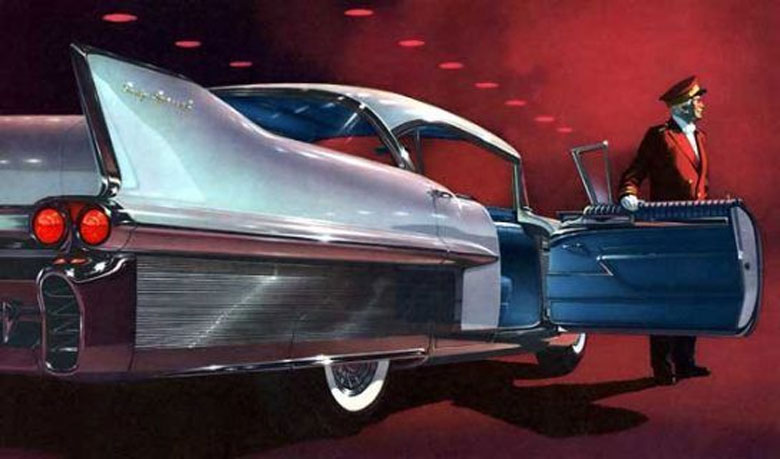
Cadillac cars had a glorious history up until the days of downsizing, they had dramatic proportion and inspired styling to match. Small roofs and large bodies were the norm. Along with that was technological leadership over its GM brothers and usually the rest of the industry. Cadillac, an American car, was driven by kings, presidents, movie stars and everyday Americans with great aspirations who felt that owning or riding in a Cadillac was seen as special. Cadillac design inspired the European manufacturers after World War II in many ways.
The much smaller 1986 Cadillac Seville and Eldorado, in spite of their clear Cadillac design character, were a disaster in the car business and the dealers were running out of money. By loyally staying with Cadillac, many had lost their personal life savings. Sales tanked and Cadillac was in trouble. Something had to be done, and quickly.
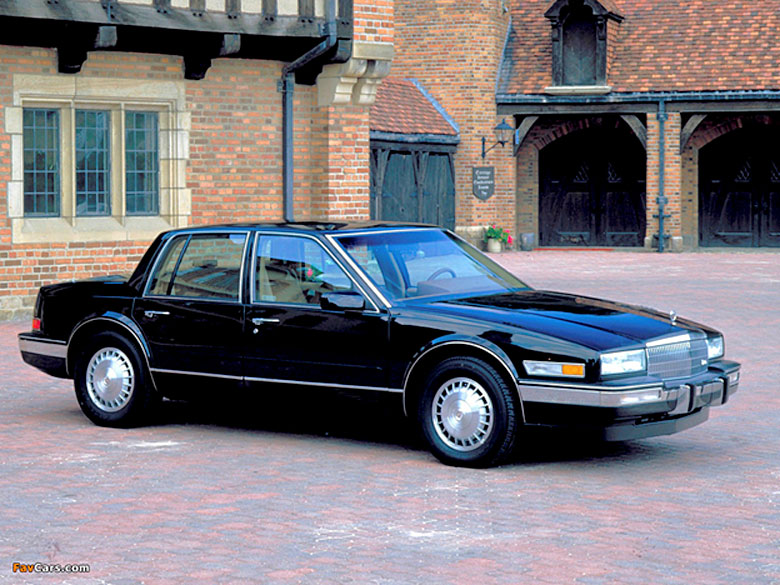
The 1986 Seville. Seen as too small, it looked like a Cadillac but it’s proportion confused people and they could not accept it as reality. It was too short and the tall side glass, very popular at the time, made the roof look big and that visually reduced the size of the body. This was the opposite of what Cadillacs had been for years.
In a short three years between 1989 and 1991, Cadillac Studio would completely redesign the Cadillac product line at a cost of over a billion dollars. Success or failure of the new cars we had designed would determine the future of the hallowed Cadillac Division and the General Motors Corporation. The new designs had to conform to stricter government fuel requirements; weight and aerodynamics would be more important than ever.
Furthermore, the design of the 1992 Cadillac Eldorado (but not the four-door Seville) initiated a contest between two car design staffs and two Italian designers. Pininfarina from Italy, creator of the Cadillac Allante, and the other, the Cadillac Studio headed by myself, an Italian American from immigrant parents who had never designed a Cadillac in his life. One design would be created in Italy, and the other at the General Motors Technical Center in America. It was a complex international journey that took many twists and turns but resulted in a beautiful car that still turns heads today over thirty years later.
This is the story of that design adventure. When you read this, please understand that this was emphatically not a normal design effort. In my forty year career working in the USA and in many other parts of the world, no other design experience was even close to this one. General Motors could not take the easy way out.
THE CHALLENGES
I had been assigned to the Cadillac Studio from Chevrolet Two Studio in 1987 under Design Vice President Chuck Jordan and was assigned to lead our design team to create a new design culture for Cadillac, starting with the design of the 1992 Eldorado and Seville that were followed by the Deville and Fleetwood.
Both cars were to be designed simultaneously, with the Seville one month ahead of the Eldorado. Designing two production cars at once in the same studio was unusual and rarely done at Design, but the cars shared many components and management had decided that to guarantee consistency of design character, and ensure the utmost in speed of the design process, it must be done that way. Note that our competition at Pininfarina only had to design one car, the Eldorado, while we were to design the Seville as well.
To make the situation even more stressful, two weeks after arriving in Cadillac Studio, Chuck Jordan’s assistant, Dave Holls, told me that if the GM Board of Directors did not approve the cars we were to do, if they did not personally see them as good looking enough, then Cadillac Division, whose complete line was a failure at that point, would be terminated. That’s right, Cadillac would be put out of business. I was not able to process that information, it was incomprehensible. Chuck Jordan, Dave Holls and I were the only people in the building who knew that.
An all-out effort at Design and at Cadillac Division was in place to create two cars that would represent GM and America against the two new Japanese brands, Lexus and Infiniti, as well as those from Europe. Design Staff’s Advance Design group was also engaged to help, and they did. Every person in the Cadillac Studio was handpicked by Design management and myself for the assignment.
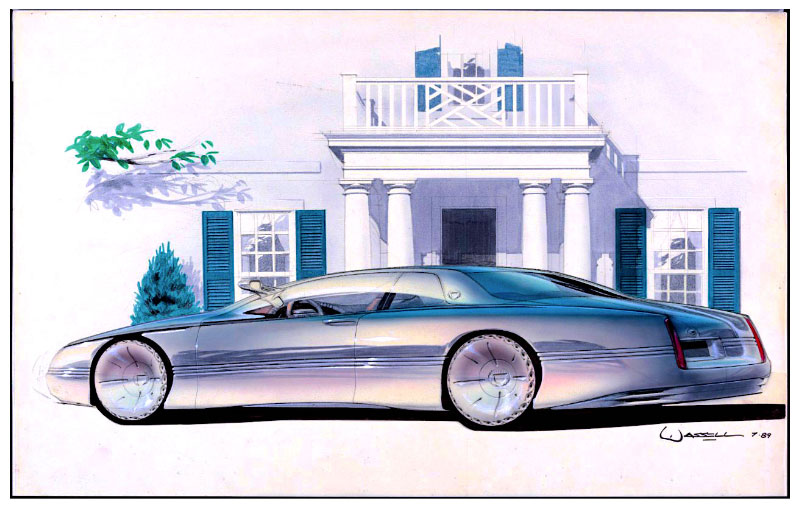
This beautifully done sketch by Cadillac designer Scott Wassell is a great example of the creative aesthetic design talent present in the studio during the 1992 Cadillac Eldorado and Seville design program. This rounded design had many of the correct and required attributes but did not have the taught linear drama that was finally present in the final Eldorado design solution. The Cadillac Studio design team started with Dick Ruzzin and assistant Dennis Little, with Larry Erickson, Scott Wassell and Gary Smith as designers. Later Ben Salvador and Brian Baker were to join us.
It would be Chuck Jordan’s greatest challenge as the new Design Vice President. We worked like dogs for over two years; overtime every night except Friday, on Saturdays and many Sundays. The urgency was exceptional and we were all driven to create the best car designs for Cadillac that we possibly could. The answer for the design of both the Seville and Eldorado eluded us no matter how hard we worked. We tried many themes in the form of full-size renderings and in clay on our full-size models. We were working rapidly but we moved slowly forward with many false starts.
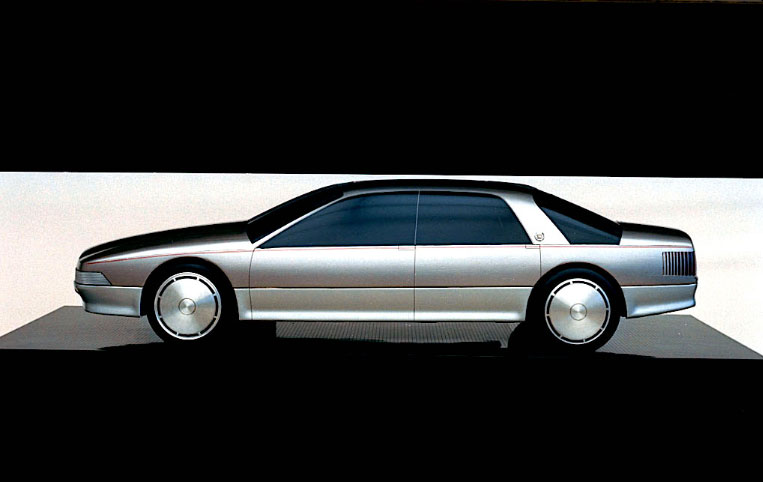
This 1/3rd size scale model represents one of the many and varied Seville design proposals that were created in the Cadillac Studio. Also many full-size renderings were done as the full-size clay model was developed. Due to the timing urgency the designers created several new and never seen before presentation techniques. Using cardboard and silver and black paper to create full-size representations of designs that helped build a design culture to ultimately arrive at a design for the Seville and the Eldorado in record time.
After a year of hard work, the Cadillac Design team consisting of my assistant Dennis Little, Gary Smith, Larry Erikson, Scott Wassell and myself, could not point to a single sketch that we felt met all of our studio expectations, much less what Design management, the Cadillac Division and the General Motors Corporation would be happy with. We had started to develop some very interesting concepts but none of us felt that we had the answer, or at least the one that the Cadillac Studio was enthusiastic about presenting to Design management as the answer. What the cars should be like was still maturing in everyone’s mind. The solution was a moving target, we were chasing it but it was moving too fast for us to catch.
DOWNSIZING DISASTERS
Cadillac Engineering was also on the line as Cadillac had to move strongly toward a more efficient and performance oriented driving experience. Cadillac had to meet the new government safety and fuel economy regulations which meant more fuel efficient and safer cars for the American consumer. However, the need to create smaller, more efficient cars denied Cadillac their traditional technology and size advantage over the other five GM divisions. Size, that had historically been so important for Cadillac, was the last thing that they finally lost due to downsizing.
When the new downsized platform drawings were rolled out to the Cadillac designers for the upcoming 1986 Cadillac Eldorado and Seville program, they were horrified. Overall length was to be reduced by over 18 inches and wheelbase by 10 inches, width also by over 4 inches. In other words, shorter, taller and narrower, the opposite of the success formula that Cadillac had enjoyed for years. The previous Cadillac Studio designers had tried very hard but the size and proportions were wrong and they had no support for changing them. Those small Cadillacs, produced from 1986 through 1991, were designed by good, dedicated professional car designers who had great love for Cadillac. But the cars were a huge market disappointment and the Corporation was keeping Cadillac monetarily afloat until the new cars…designed by our team… came out.
And, for the Eldorado design, there was the emerging threat from Pininfarina in Italy.
Thank you Pete for doing this. In retrospect over thirty years later with a clear mind not encumbered by daily tasks and crisis I realized while writing this article much that I was not aware during those times. It is a great American industrial story and a genuine crisis that was faced by General Motors. It was not their fault. They fought hard and Cadillac survived.
During this time period I worked as a salesman at a Lincoln dealership in Florida. I clearly remember all the OLD Cadillac customers coming in to compare the new Lincoln’s to the smaller Caddies. We converted very few. Cadillac buyers were just as committed to the brand as the dealers were. The dealership we we competed against eventually folded. A large dealer chain from NYC & Miami acquired it.
I like the confessional aspect, I think as new automakers emerge( dare I mention Evil Elon) we as teachers of our children need to be able to tell the truth about where Detroit went wrong, in the changeover to smaller cars and now the changeover to EVs.
One thing I would like answered is one only an insider like Dick can answer: how much did buying a foreign car (particularly an exotic)torpedo your career at GM, Ford or Chrysler? I know there were people that owned Ferraris , Porsches etc. but I bet they didn’t drive to too many social occasions in them. I always thought this was narrow minded of management because when you told a designer “do the taillight like a Porsche” a Michigan native was clueless in that they didn’t see many Porsches
PS If it sounds like I am familiar with Mr. Ruzzin, I even went to a party at his house when I was a copywriter for Chevrolet…must have been a half century ago…